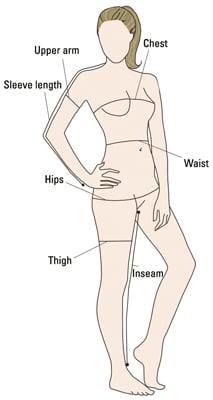To Get Your Body Measurements can be intimidating.
Rather than assuming that you know your body measurements, it would be much wiser to measure it yourself after at all it’s not that difficult to take those measurements yourself and assure the perfect fit. Going to a professional is the best way to get accurate measurements, but if that is not possible, most certainly anyone can handling the measuring tape and measure yourself. The most important measurements are: chest, waist, hips. You may also want to take your thigh and upper arm measurements. The process is not complicated at all, as a matter of fact, its pretty simple.
Just by using a simple tape measure, you can get a perfect idea of what size to order or to make your clothes. That will help you tremendously when ordering online. But if you want that perfect fit, just be a bit more specific with your measurements.
This will help you determine your size.
Make sure that, when you circle your chest, waist, or hips, the tape is level and neither too tight nor too loose. Also measure yourself on your bare skin, not over clothes, make sure to take notes. Here is a simple chart that I happen to find online in order to guide you.
- Chest: Measure the circumference of your chest. Place one end of the tape measure at the fullest part of your bust, wrap it around (under your armpits, around your shoulder blades, and back to the front) to get the measurement.
- Waist: Measure the circumference of your waist. Use the tape to circle your waist (sort of like a belt would) at your natural waistline, which is located above your belly button and below your rib cage. (If you bend to the side, the crease that forms is your natural waistline.) Don’t suck in your stomach, or you’ll get a false measurement. If you generally wear your clothes below your waist, take that measurement as well.
- Hips: Measure the circumference of your hips. Start at one hip and wrap the tape measure around your rear, around the other hip, and back to where you started. Make sure the tape is over the largest part of your buttocks. Because making sure the tape is level back there can be hard, try to do it in front of a mirror.
- Inseam: This is the distance from the uppermost inner part of your thigh to the bottom of your ankle. You can measure your inseam in two ways.
- With help: While you’re wearing a pair of pants, have a friend stretch the tape from your crotch to the bottom of your ankle
- Without help: If you have a pair of pants that fit you perfectly (and they shouldn’t be too loose around the waist), measure the inseam of the pants, again from the crotch to the hem. The proper inseam on a pair of pants you’re going to purchase will depend on the height of the heel you’ll be wearing with them.
- Thigh: Measure the circumference of the fullest part of your thigh. Wrap the tape measure around your thigh from front to back and then around to the front. You may be tempted to cheat by lowering the tape measure a few inches, but then you won’t get an accurate measurement.
- Upper arm: Measure the circumference of your arm. Wrap the tape measure around the widest part of your upper arm from front to back and around to the start point.
- Back: If the dress has a sleeve this measurement will assure a perfect and comfortable fit. This should be taken across you back from arm to arm, pretty much where the seam for the sleeves would be placed.
- Sleeve length: Place your hand at your waist (your elbow should be bent at a 90-degree angle). (Imagine a line where your arm drops down) then measure from that line down to the elbow, and then on to the wrist. Or to where you desire the sleep to hit.
- Torso length: If you are considering having a dress that has a waistline, this measurement is very important.
- Skirt length: Different strokes for different folks, everywomen has a preferred length when it comes to dresses, either short or long this measurements will make it or break it. So take into consideration where the ham must be placed.
When you are measuring yourself if possible do so in front of the mirror to ensure the tape measure is horizontally positioned around your body.
If the subject is pants or shorts the measurements are done differently.
- Waist–Measure the smallest part of the waist. Leave a tape or ribbon tied snugly around the waist while taking other measurements.
- Hips–Measure the fullest part of the hips. Also record the distance from the waist down to tape, located at the fullest area.
- Abdomen–Measure about 3 to 4 inches below the waistline over the fullest part of the abdomen.
- Thigh–Just below the crotch, around the leg.
- Knee–Measure around the knee with the knee slightly flexed.
- Calf–Measure around the calf.
- Instep–Measure around heel over the instep. This measurement is necessary for narrow tapered pants. Be sure to allow enough room for the foot to slip through.
- Side length to knee–Measure from the waist to the knee.
- Side length–Measure from the waist to the desired length.
- Crotch
- One way Can be done in two ways, the easiest way is just to put the tape between your legs from back to front, making sure that it’s the hight that you want the waist to be, then just divide by 2. For sewing purpose this is crucial the back part is always bigger then the front, this will make sure to fit perfectly on the back.
- Second way
a. Depth–Sit on flat chair, bench, floor, or table. Measure from waist to top of flat surface.
b. Length–Determine measurement from front waist to center of body and from center of body to back waist.

PRINTABLE MEASURING CHART FOR WOMEN
Just one click away.
https://learntosewathome.com/printable-body-measurement-chart/
This link will give you more ideas and an understanding of how to get your measurements and also allow you to print and make your notes perfectly. There are charts for men and women.
With measurements for pants or shorts, it’s always a smart idea to add extra inches depending or your activities. Most people light a loose-fitting for lounging and perhaps a more fitting for a casual outing.
With all this new information just take the time to take the right messurments and have your clothe done to your body and taste.






